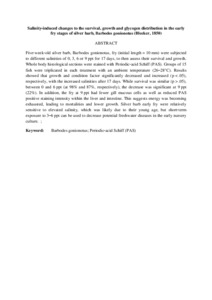Citation
Romano, N. and Syukri, F. and Karami, A. and Omar, N. and Khalid, N. I.
(2017)
Salinity-induced changes to the survival, growth and glycogen distribution in the early fry stages of silver barb, Barbodes gonionotus (Bleeker, 1850).
Journal of Applied Ichthyology, 33 (3).
509 - 514.
ISSN 0175-8659; ESSN: 1439-0426
Abstract
Five‐week‐old silver barb, Barbodes gonionotus, fry (initial length = 10 mm) were subjected to different salinities of 0, 3, 6 or 9 ppt for 17 days, to then assess their survival and growth. Whole body histological sections were stained with Periodic‐acid Schiff (PAS). Groups of 15 fish were triplicated in each treatment with an ambient temperature (26–28°C). Results showed that growth and condition factor significantly decreased and increased (p < .05), respectively, with the increased salinities after 17 days. While survival was similar (p > .05), between 0 and 6 ppt (at 98% and 87%, respectively), the decrease was significant at 9 ppt (22%). In addition, the fry at 9 ppt had fewer gill mucous cells as well as reduced PAS positive staining intensity within the liver and intestine. This suggests energy was becoming exhausted, leading to mortalities and lower growth. Silver barb early fry were relatively sensitive to elevated salinity, which was likely due to their young age, but short‐term exposure to 3–6 ppt can be used to decrease potential freshwater diseases in the early nursery culture.
Download File
![[img]](http://psasir.upm.edu.my/63173/1.hassmallThumbnailVersion/Salinity%E2%80%90induced%20changes%20to%20the%20survival%2C%20growth%20and%20glycogen%20distribution%20in%20the%20early%20.pdf)  Preview |
|
Text (Abstract)
Salinity‐induced changes to the survival, growth and glycogen distribution in the early .pdf
Download (217kB)
| Preview
|
|
Additional Metadata
Actions (login required)
 |
View Item |

